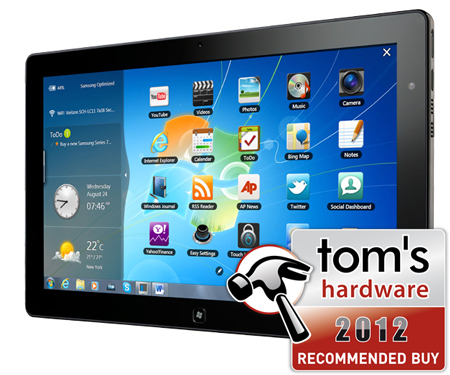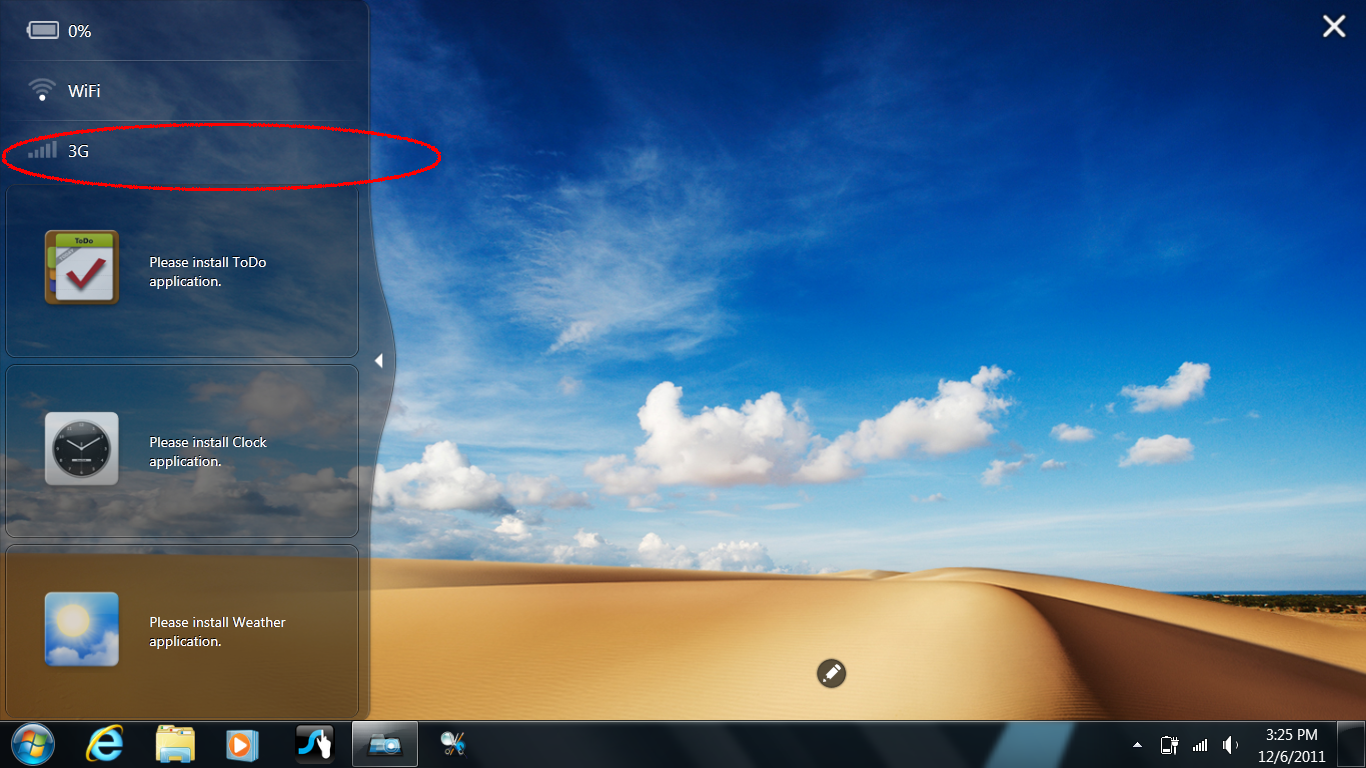Samsung Series 7 11.6" Slate: Breathing New Life Into Tablet PCs
Samsung's Series 7 11.6" Slate Is The Best Windows-Based Tablet We've Seen
Prior to Intel's Sandy Bridge architecture, there was too large a gap between desktop and mobile devices for us to be satisfied with a notebook that could take the place of a stationary workstation. Fortunately, the efficiency improvements inherent to Intel's latest design help bright that gap to a significant degree. Now more so than ever, it's possible to completely forgo a desktop for productivity-oriented tasks without kicking yourself in the shin over performance compromises.
Why should you care? Tablet PCs are intended to replace notebooks. The familiar clam shell form factor makes it easy to balance desktop-class parts, a battery pack, a big screen, and the convenience of a complete keyboard. Smashing everything down into a single plane naturally amplifies the space constraints tablet vendors working with very low-power mobile technology are forced to accept. And that's why most tablet PC designers are forced to settle on previous-generation hardware for their tablet PC efforts, as illustrated by Asus' Eee Slate. Of course, nobody wants to toss a modern desktop in favor of a mobile platform based on old components.
Enter Samsung's Series 7 11.6" Slate.
| Pricing | 16 GB | 32 GB | 64 GB | 128 GB |
|---|---|---|---|---|
| iPad 2 (Wi-Fi) | $499 | $599 | $699 | - |
| iPad 2 (AT&T/Verizon 3G) | $629 | $729 | $829 | - |
| Xoom (Wi-Fi) | - | $499 | - | - |
| Iconia Tab A500 (Wi-Fi) | $449 | - | - | - |
| Eee Slate E121 | - | $999 | $1299 | - |
| Eee Slate B121 | - | - | $1499 | - |
| Series 7 11.6" Slate | - | - | $1049 | $1349 |
Intel's Sandy Bridge architecture flips the script on all of that. A more efficient architecture actually makes it easier to incorporate modern hardware into a tablet PC's limited dimensions, offering better performance and eating less battery power in the process. That's what Samsung demonstrates with its Series 7 11.6" Slate. It's the first tablet PC capable of replacing a notebook, while delivering desktop-class performance, and in a more mobile package. If you're a road warrior, consolidating the number of devices you tote around is finally possible. Of course, that assumes you're also willing to buy Samsung's docking station, which runs another $100.
But even after that extra cost, the Slate's price tag is more competitive with ultraportable Sandy Bridge-based notebooks than other tablet PCs. Similarly-priced solutions from Motion Computing employ Atom processors, while more expensive offerings from companies like Asus still leverage slower Arrandale-class hardware.
Samsung didn't just slap together hardware haphazardly and rely on Microsoft's operating system to make this work as a tablet. The company actually took the time to create a customized touchscreen interface that almost embarrassingly feels easier to use than Windows 8's Metro. The fact that this is the first and only tablet PC based on a Sandy Bridge-based platform, yielding great performance, is a major bonus.
Interestingly, this is the exact same tablet PC that Microsoft distributed at its BUILD conference to encourage Windows 8 development. Yet, Samsung hasn't really made any effort to promote it, which is a shame. It's a phenomenal device that delivers much better value than the competition, which is why the Series 7 11.6" Slate deserves our Tom Hardware's 2012 Recommended Buy award.
Get Tom's Hardware's best news and in-depth reviews, straight to your inbox.
The Series 7 11.6" Slate isn't without its faults. In order to achieve a thin and sexy design, Samsung chose to omit the seemingly very basic pen holder. As a result, it's super easy to lose the digitizer-enabled pen. Fortunately, the Series 7 11.6" Slate uses a touchscreen, so forgetting where you put the pen isn't a huge problem unless you need to take hand-written notes. Buy a case to easily remedy Samsung's oversight. You'd probably end up snagging on anyway.
Despite our very minor complaint, Samsung comes very close to proffering the perfect tablet PC. The design of this slate makes sense.
Current page: Samsung's Series 7 11.6" Slate Is The Best Windows-Based Tablet We've Seen
Prev Page Wireless Performance Next Page Background Information On Our Benchmarks-
g-unit1111 Do. Want. Finally - a tablet that doesn't require a proprietary operating system that needs 1,000,000,000 apps for every website on the internet in order to function properly. It has an SSD and not flash memory. It has a real working version of Windows - with a great interface on top of it. This looks like a tablet I can get behind.Reply -
A very nice tablet! Hoping that ivy bridge will allow faster processers without creating too much heat and saving battery. I'm really looking into getting a tablet in the future to replace my notebook and this looks is very reassuring that things are improving :P.Reply
-
What about the digitizer? I appreciate the comparisons to the Asus EEE Slate, but that has a 256-level pressure sensitive wacom digitizer on top of the screen. And no mention of it or what is on this device?Reply
-
joytech22 Yay finally, I saw this in shops around a month ago and wonder when tom's would cover it. :pReply -
Gamer-girl The UI makes it seem like a smartphone. You keep mentioning the pen but there is no comparison? Does it have palm rejection?Reply -
theuniquegamer Instead of current sandybridge (i.e hd 3000) the should give an amd llano which has a better gpu or the ivy bridge mobile cpus (which is with hd 4000 gpu) and a lower TDP.Reply -
alyoshka Isn't it a little steep for a 1000$....??? After all it's a Samsung, 11.6Inch Tab.......Reply
I think it'd be a lot more wiser to buy a laptop for that price and get a much more efficient and powerful piece of tech. -
alyoshka I would have given the Note from Samsung a thought had it had 7.5 installed on it..... but again..... it's a samsung.....Reply

